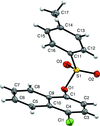issue contents
June 2018 issue

Cover illustration: 2-Aminopyrimidine pharmacophores have shown a broad spectrum of biological activities, including use against Parkinson's disease, and display anti-bacterial, anti-platelet, antidiabetic and antitumor properties. 4-(3,5-Dimethoxyphenyl)-6-(2-methoxyphenyl)pyrimidin-2-amine was synthesized in a continuation of a research program to expand the use of novel synthetic chalcones. See: Koh & Lee [IUCrData (2017). 3, x180796].
metal-organic compounds
Download citation


Download citation


Open  access
access
 access
accessThe organic–inorganic hybrid salt, (C8H12NO)2[CdBr4], is made up from two 4-methoxybenzylammonium cations and a [CdBr4]2− anion. The cations lie about layers of anions that extend along the ac diagonal.
CCDC reference: 1814527
Download citation


Download citation


Open  access
access
 access
accessThe title compound is a cobalt(III) dibromide base having a bromido and a methylamine substituent cis to each other. In the crystal, the complex cation and the two counter-anions are linked via N—H⋯Br and C—H⋯Br hydrogen bonds, forming a supramolecular framework.
CCDC reference: 894718
Download citation


Download citation


Open  access
access
 access
accessThe title compound, C6H23Br3CoN5, is a cobalt(III) dibromide complex having a cis arrangement for ethylenediamine chelating ligands.
CCDC reference: 785726
Download citation


Download citation


Open  access
access
 access
accessThe coordination polyhedra of the sodium ions are connected by common edges forming an infinite chain of ions along the [100] axis. The chains and betaine zwitterions are assembled into infinitive layers via hydrogen bonds.
CCDC reference: 1848958
Download citation


Download citation


Open  access
access
 access
accessThe title compound consists of a chloride anion interacting through O—H⋯Cl hydrogen bonds with a cobalt(II) complex cation, leading to a three-dimensional supramolecular network.
CCDC reference: 1848987
Download citation


Download citation


Open  access
access
 access
accessThe title compound, a one-dimensional chain coordination polymer, was prepared during synthetic attempts to prepare divalent metal coordination polymers containing both iminodiacetate and 4,4′-dipyridylamine ligands.
CCDC reference: 1848969
Download citation


Download citation


Open  access
access
 access
accessThe title complex C28H30MoN2O4P2 contains a molybdenum centre bearing a Ph2PN(iPr)P(Ph)NH(iPr) and four carbonyl ligands in a distorted octahedral coordination geometry.
CCDC reference: 1848117
Download citation


Download citation


Open  access
access
 access
accessThe Fe atom adopts a square-based pyramidal coordination geometry with the carbonyl groups and the two C=C bonds of the diene defining the basal sites and the phosphane ligand the apical position. The diene ligand has an E,E geometry, with the phosphonium fragment pointed away from the Fe atom.
CCDC reference: 1850684
Download citation


Download citation


Open  access
access
 access
accessIn Rb–Na saccharinate, ions are bound by electrostatic attraction, hydrogen bonds, and stacking interactions.
CCDC reference: 1849000
organic compounds
Download citation


Download citation


Open  access
access
 access
accessThe synthesis, molecular and crystal structure of a biologically important pharmacophore containing 2-aminopyrimidine is reported.
CCDC reference: 1846182
Download citation


Download citation


Open  access
access
 access
accessThe molecular and crystal structor of the title compound is reported. The crystal structure features C—H⋯π ring interactions.
CCDC reference: 1844781
Download citation


Download citation


Open  access
access
 access
accessN-(4-Chlorophenyl)-N′-{4-[(Z)-hydroxy(1-oxo-1,3-dihydro-2H-inden-2-ylidene)methyl]phenyl}urea
In the title compound, molecules are linked by N—H⋯O hydrogen bonds, generating infinite [100] chains incorporating  (6) ring motifs.
(6) ring motifs.
CCDC reference: 1846924
Download citation


Download citation


Open  access
access
 access
accessThis report highlights the crystals structure of a tri-protonated tris(2-pyridylmethyl)amine (TPMA) ligand with three chloride counter-ions.
CCDC reference: 1847161
Download citation


Download citation


Open  access
access
 access
accessIn the crystal, the molecules are linked by pairs of C—H⋯O hydrogen bonds, generating  (14) inversion dimers; further C—H⋯O hydrogen bonds connect the dimers into [100] double chains.
(14) inversion dimers; further C—H⋯O hydrogen bonds connect the dimers into [100] double chains.
CCDC reference: 1842509
Download citation


Download citation


Open  access
access
 access
accessThe asymmetric unit comprises two independent molecules of C19H16N4O3, which pack in pairs related by inversion.
CCDC reference: 1847818
Download citation


Download citation


Open  access
access
 access
accessThe structure of this title cage compound encompasses seven fused rings, viz. one four-membered, five five-membered and one six-membered. The four-membered ring is essentially planar, all five-membered rings adopt an envelope conformation and the six-membered ring adopts a boat conformation.
CCDC reference: 1842060
Download citation


Download citation


Open  access
access
 access
accessThe heterocyclic portion of the dihydroquinoxaline unit is distinctly non-planar. The crystal packing consists of corrugated layers constructed by O—H⋯O, O—H⋯N and C—H⋯O hydrogen bonds which involve the lattice water molecules. O—H⋯O hydrogen bonds and π–π stacking interactions hold the layers together.
CCDC reference: 1849737
Download citation


Download citation


Open  access
access
 access
accessThe complete molecule of the title compound is generated by crystallographic inversion symmetry.
CCDC reference: 1849908
Download citation


Download citation


Open  access
access
 access
accessThe structure of a chloronaphthalene tosylate derivative is reported. The naphthalene ring system and the benzene ring of the tosylate substituent are inclined to one another by 55.32 (5)°. The crystal structure features C—H⋯O hydrogen bonds and a weak Cl⋯Cl halogen bond.
CCDC reference: 1849905
Download citation


Download citation


Open  access
access
 access
accessApart from the ethyl substituent, the title compound is approximately planar.
CCDC reference: 1850161
Download citation


Download citation


Open  access
access
 access
accessThe organic molecule in the title hydrate is folded across the S⋯N vector. The crystal structure features N—H⋯O, O—H⋯O and C—H⋯O hydrogen bonds.
CCDC reference: 1849866
Download citation


Download citation


Open  access
access
 access
accessThe pyrazolopyrimidine unit in the title compound is slightly non-planar.
CCDC reference: 1849367
Download citation


Download citation


Open  access
access
 access
accessThe extended structure of the title molecular salt features [010] chains linked by N—H⋯O hydrogen bonds.
CCDC reference: 1849402


 journal menu
journal menu


































![[publCIF]](/logos/authorchecklist11.gif)





